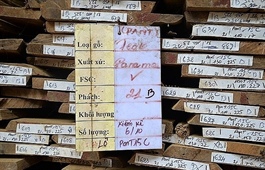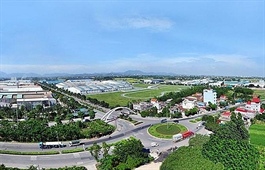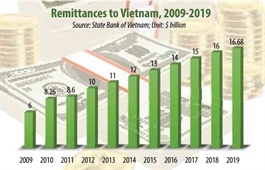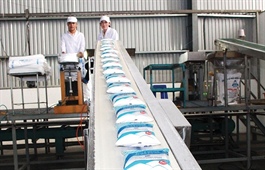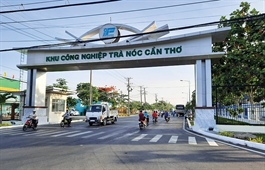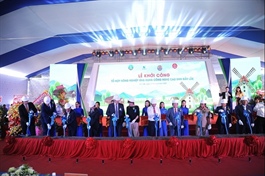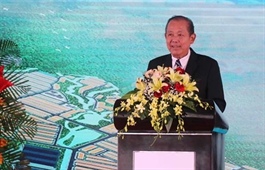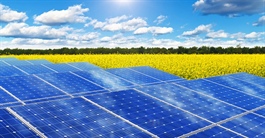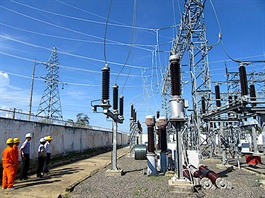Adjusting trade promotion strategies
Adjusting trade promotion strategies
Trade promotion activities have helped Vietnam to not only reach export surpluses throughout most of the last decade but also extend its reach towards 12 times the amount of countries and territories in 2000. Vu Ba Phu, director general of the Trade Promotion Agency under the Ministry of Industry and Trade, discussed with Van Nguyen current bottlenecks that hinder further expansion of trade promotion abroad.

Vu Ba Phu, director general of the Trade Promotion Agency under the Ministry of Industry and Trade
|
COVID-19 has clarified the shortcomings of trade promotion, especially when it comes to funding. What is the current status of this?
The annual budget for trade promotion is granted by the Ministry of Industry and Trade and amounts to around $5-6 million, which is equivalent to about 0.0011 per cent of Vietnam’s total import-export turnover.
Compared to other regional countries, this budget is minuscule concerning actual needs and the correlation with the nation’s export turnover. For a better understanding, the promotion budgets of economies like Japan, South Korea, India, and Thailand all sit at about 0.2-0.3 per cent – a big difference.
Between 2003 and 2019, the Trade Promotion Agency asked the MoIT minister for approval of over 3,200 national trade promotion projects with total funding at around VND2.1 trillion ($91.3 million). All these key projects focused on the three main contents, export promotion, trade promotion in the domestic market, and trade promotion in mountainous, border, and island regions.
How has the nation been dealing with the difficulties for Vietnam’s import-export growth that have been caused by the incompatible funding?
Trade promotion is an activity that the government needs to invest in and lead appropriately to achieve the 7-per-cent increase in total export turnover and stay under the 3-per-cent marker in trade deficit that was set by the National Assembly for this year.
Activities under the National Trade Promotion Programme have supported around 100,000 businesses in participating in trade promotions. These companies have been closing deals and signing contracts, reaching a total export contract value of around VND1 trillion ($43.47 million) and around VND3 trillion ($130.4 million) in contracts for domestically traded goods.
Meanwhile, ministries and agencies have been establishing market development departments that led to localities building trade promotion centres. Moreover, industry associations, and even private enterprises, have been supporting trade promotion activities.
This situation is very different from one or two decades before when the Trade Promotion Department was the sole institution to carry out trade activities, expand markets, and bring domestic enterprises to fairs and exhibitions.
What do you see as role of businesses participating in trade promotion?
The results of the nation’s trade promotion in recent years show that Vietnamese enterprises have been paying more attention to this activity, with the number of them registering to partake increasing steadily each year. They have been provided with certain skills in trade promotion, market access development, and professionalism.
Nevertheless, it is difficult to organise an effective trade promotion when nearly 97 per cent of Vietnamese companies are small- and medium-sized, or even micro, businesses with only limited resources both in human and financial capital. Thus, the role of the government and state management agencies in fostering trade promotion together with associations and localities and equipping businesses with the necessary skills and knowledge is extremely important.
These enterprises must then be further supported to carry out trade promotion activities and attend international fairs and exhibitions. For instance, the government could support them in participating in e-commerce activities and opening digital booths on professional online marketplaces. Normally, businesses would have to pay fees of up to several thousand dollars per year to do so – too much for most micro-sized businesses.
How have trade promotions had to be adjusted to suit the post-pandemic global market?
Amid the pandemic, traditional forms of trade promotions have been stopped as they were simply impossible to carry out. To tackle this issue, we have immediately deployed several online activities, such as webinars and conferences, between Vietnamese businesses and potential trade partners to support trade promotion.
These online trading activities have helped businesses save costs and find many new partners, and many domestic enterprises have registered to participate. However, only few contracts have been recorded as most people seem to be accustomed to negotiations in person.
As the pandemic’s development remains complicated globally, the Trade Promotion Agency will continue to establish online connections to expand markets all over the world, with priority being given to export markets for agricultural and aquatic products and imports of raw materials for production and export.
Nevertheless, promoting trade even after the pandemic will certainly be more difficult than before. Therefore, the government should prioritise trade promotion and further up its budget, focusing on key markets with specific activities and audiences.
For example, trade promotion with the European market needs support for small- and medium-sized enterprises so that they can rent booths and afford air tickets, while large corporations could be assisted with promoting their brands and products.
|
National Trade Promotion Programme achievements The National Trade Promotion Programme has achieved many positive results, making major contributions mainly in two important areas. Firstly, export turnover has been growing continuously over recent years. Thus, Vietnam was able to reach a trade surplus in the years between 2012 and 2014 as well as between 2016 and 2019 after many consecutive years of trade deficits. Secondly, the programme has restructured exports towards increasing the proportion of processed products and those with added value as well as associated services. Particularly in 2019, export turnover reached $264.19 billion, up 8.4 per cent compared to 2018 and 82.2 per cent compared to 2000. Meanwhile, import turnover hit $253.07 billion, up 6.8 per cent against 2018 and 61.91 per cent more than in 2000. Thus, the trade balance of goods saw an export surplus of $11.11 billion in 2019. With the help of trade promotion activities, Vietnam’s export markets have been continuously increasing from 15 countries and territories in 2000 over 72 in 2009 to 180 in 2019. |






